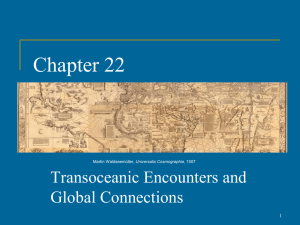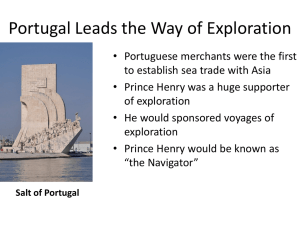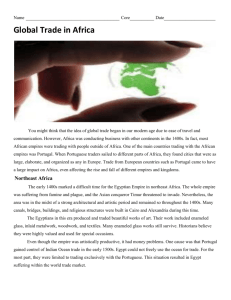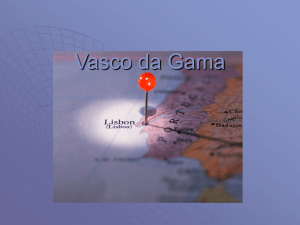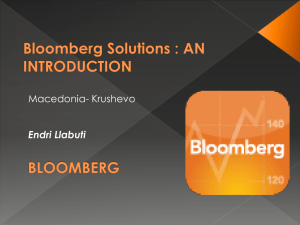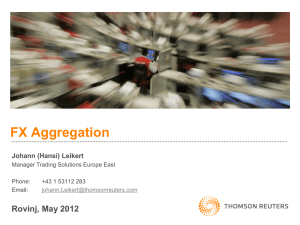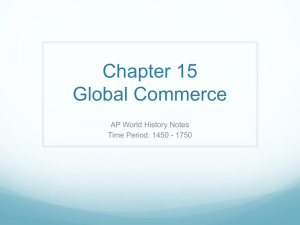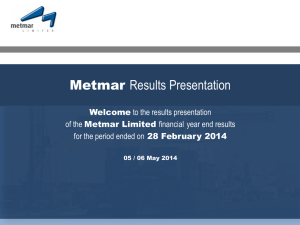European empires in Asia
advertisement
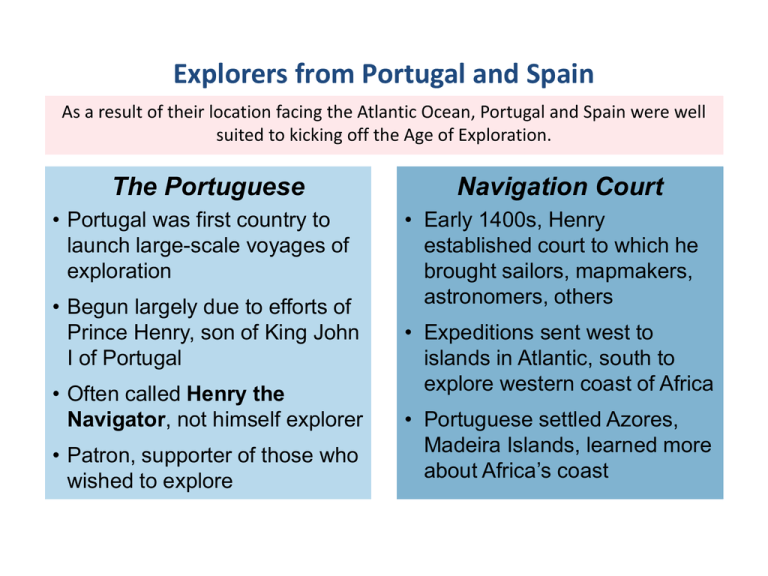
Explorers from Portugal and Spain As a result of their location facing the Atlantic Ocean, Portugal and Spain were well suited to kicking off the Age of Exploration. The Portuguese • Portugal was first country to launch large-scale voyages of exploration • Begun largely due to efforts of Prince Henry, son of King John I of Portugal • Often called Henry the Navigator, not himself explorer • Patron, supporter of those who wished to explore Navigation Court • Early 1400s, Henry established court to which he brought sailors, mapmakers, astronomers, others • Expeditions sent west to islands in Atlantic, south to explore western coast of Africa • Portuguese settled Azores, Madeira Islands, learned more about Africa’s coast Exploration Attempts Water Route to India • Prince Henry’s ultimate goal—find water route around Africa to India • Died before goal accomplished; attempts to find such a route not abandoned • 1488, Bartolomeu Dias became first to sail around southern tip of Africa da Gama • 1497, Vasco da Gama set out for India, stopped at several African ports • Learned Muslim merchants actively involved in trade • Journey took more than 10 months, eventually reached Calicut in India Lucrative Trade • da Gama’s trip inspired another expedition to India, led by Pedro Cabral • Sailed west; sighted, claimed land that became known as Brazil • Portugal established trading centers; became rich, powerful European nation Spain vs. Portugal • 1493 Pope Alexander VI divided these lands between Spain and Portugal • Spain got the western part; Portugal got the east. • (1494) Treaty of Tordesillas granted Brazil to Portugal by moving the line of demarcation over parts of south America. • The Portugal began conquering major trading cities in the Arabian Sea, India, & as far east as Indonesia & Malaysia. Explorers and their Routes Chapter 16, section 1, pages 472-473 European Explorations For Spices, About 1500 5 of 6 Progress Monitoring Transparency Portugal Builds an Eastern Empire • In 1497, Vasco da Gama led four ships that reached the great spice port of Calicut on the west coast of India. • In 1502, he forced a treaty of friendship on the ruler of Calicut. • As a result, the Portuguese seized key ports around the Indian Ocean to create a vast trading empire. Trading Post Empires: Portuguese Trading Posts • Portuguese trading posts were designed not to conquer territory but to control trade routes by forcing merchant vessels to stop and pay duties • By the mid-16th Century, Portuguese merchants had built more than 50 trading posts between west Africa and east Asia Portugal Builds and Eastern Empire • Afonso d’Alboquerque led the effort seizing Hormuz in 1508, Goa in 1510, and Melaka in 1511 – Alboquerque tried to control trade throughout the Indian Ocean • Goa- Island off the coast of India • Malacca- Sea port in the East Indies – Once controlled by Muslims – In 1511 the Portuguese take control of the city and massacre the cities Muslims *The Portuguese had a limited cultural impact in the region • only partially successful because of an insufficient number of ships to enforce his plan Trading Post Empires: English and Dutch Trading Posts • Like the Portuguese, the English and Dutch built trading posts on the Asian coasts but they did not attempt to control shipping on the high seas • The English and Dutch had two main advantages over the Portuguese – Faster, cheaper, and more powerful ships – Joint-stock companies Trading Post Empires: English and Dutch Trading Posts • Joint-stock companies enabled investors to realize profits while limiting risks to their investments – English East India Company – Dutch United East India Company (VOC) • Companies had government support to buy, sell, and build trading posts and even make war, but they were privately owned • Advanced nautical technology, military power, efficient organization, and relentless pursuit of profit allowed the jointstock companies to form a global trade network – The companies had the power of a sovereign nation, and came to dominate the regions Trading Post Empires: Philippines and Indonesia • In most cases the Europeans traded peacefully with the Asians (partly because they were unable to subjugate them) • The two exceptions were the Philippines and Indonesia where Europeans were able to use massive force to establish imperial regimes Trading Post Empires: Philippines and Indonesia • The Spanish arrived in the Philippines in 1565, controlled most of the coastal regions by 1575, and controlled most of the archipelago during the 17th Century • Spanish activities revolved around trade and Christianity – (Today the Philippines are 83% Roman Catholic) • The most prominent area was the port of Manila which supported the trade of silk from China with New World silver from Mexico “Manila galleons” transported cargo from the Philippines to Mexico Trading Post Empires: Philippines and Indonesia • In Indonesia, the Dutch focused on trade and did not try to win converts to Christianity – Took from Portuguese – (Today Indonesia is 88% Muslim) • The VOC established a monopoly over the spice trade, seeking less to rule than to control spice production • Used a variety of techniques – Formed local alliances, uprooted plants on islands they did not control, attacked people who sold their spices to others New Colonial Rivals Trading Post Empires: Seven Years’ War • Commercial competition ultimately generated violence – In 1746 French forces seized the English trading post at Madras, India – In the Caribbean English pirates attacked Spanish vessels and French and English forces fought over the sugar islands • The violence culminated in the Seven Years’ War (1756-1763) Trading Post Empires: Seven Years’ War • A global war – In Europe, Britain and Prussia fought against France, Austria, and Russia – In India, British and French allied with local rulers and fought each other – In the Caribbean, the Spanish and French fought the British – In North America, the Seven Years’ War merged with the on-going French and Indian War (1754-1763) which pitted the British and French against each other Trading Post Empires: Seven Years’ War • In the end Britain emerged victorious, but challenges continued • Still Britain was now in a position to dominate world trade for the foreseeable future • The Seven Years’ War paved the way for the establishment of the British Empire of the 19th Century European Footholds in South and Southeast Asia Mughal India and European Traders The British East India Company and the French East India Company both operated in Indian coastal towns with the permission of the Mughal rulers. When Britain and France went to war in the mid-1700s, the British and their Indian sepoys drove the French out of India. The British then came to dominate the subcontinent. Mughal India & European Traders A CENTER OF VALUABLE TRADE • Besides producing spices, India was the world leader in textile manufacturing. • It exported large quantities of silk and cotton cloth. • The Mughal empire was larger, richer, and more powerful than any kingdom in Europe. • Several weak rulers held the throne in the early 1700s. Mughal India & European Traders A GREAT EMPIRE SHATTERS • Corruption became widespread, and the central government eventually collapsed. • Both the English and French East India Companies made alliances with local officials and independent rajahs. • By the mid-1700s, the British and the French had become locked in a bitter struggle for global power. • In 1756, war between Britain and France erupted in Europe. • The fighting soon spread, involving both nations’ lands in Asia and the Americas. Progress Monitoring Transparency 7 of 7 The Beginnings of Our Global Age: Europe, Africa, and Asia Encounters in East Asia European Contact with Ming China The Ming allowed Europeans to come and trade, but they limited their visits to one area and to one season. Christian missionaries were welcomed for their knowledge of many subjects, but had little success in converting the Chinese. 1 of 7
